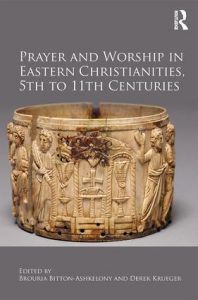
Posted on August 27, 2019
Derek Krueger, Editor
Prayer and Worship in Eastern Christianities, 5th to 11th Centuries forges a new conversation about the diversity of Christianities in the medieval eastern Mediterranean, centered on the history of practice, looking at liturgy, performance, prayer, poetry, and the material culture of worship. It studies prayer and worship in the variety of Christian communities that thrived from late antiquity to the middle ages: Byzantine Orthodoxy, Syrian Orthodoxy, and the Church of the East. Rather than focusing on doctrinal differences and analyzing divergent patterns of thought, the essays address common patterns of worship, individual and collective prayer, hymnography and liturgy, as well as the indigenous theories that undergirded Christian practices. The volume intervenes in standard academic discourses about Christian difference with an exploration of common patterns of celebration, commemoration, and self-discipline.
Essays by both established and promising, younger scholars interrogate elements of continuity and change over time – before and after the rise of Islam, both under the control of the Eastern Roman Empire and in the lands of successive caliphates. Groups distinct in their allegiances nevertheless shared a common religious heritage and recognized each other – even in their differences – as kinds of Christianity. A series of chapters explore the theory and practice of prayer from Greco-Roman late antiquity to the Syriac middle ages, highlighting the transmission of monastic discourses about prayer, especially among Syrian and Palestinian ascetic teachers. Another set of essays examines localization of prayer within churches through inscriptions, donations, dedications, and incubation. Other chapters treat the composition and transmission of hymns to adorn the liturgy and articulate the emotions of the Christian calendar, structuring liturgical and eschatological time.
To see more faculty’s books, click the link.